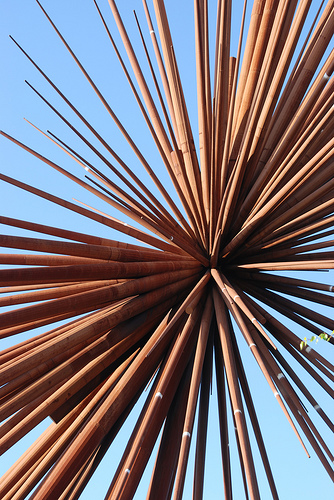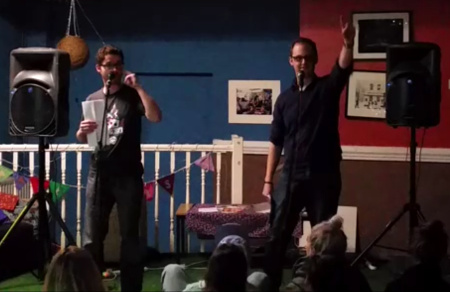B of the Bang: 2005-2009
Article published: Thursday, August 20th 2009
B of the Bang, which has just been dismantled, was a Manchester icon. A 56 metre high reminder of what the city stood for, the sculpture was commissioned to celebrate the success of the 2002 Commonwealth Games. Built outside Manchester City’s new Eastlands stadium, it took its name from the sprinter Linford Christie’s claim that he starts a race on the ‘B of the Bang’ of the starting pistol.

Designed by Thomas Heatherwick – best known for his folding footbridge in London – B of the Bang was erected to capture the city’s ‘innovative and pioneering spirit’. Comprised of hollow spikes exploding like a firework over the city, it became as much a part of the Manchester skyline as the peaks in the background.
B of the Bang was more than a piece of artwork, though, it was a reminder of a new Manchester full of ambition and hope, rebuilding itself after decades of decline. Its spikes reached for new ambitions, stretching across the sky for something in the distance, beyond their reach. Splayed dramatically across Manchester postcards, it became one of the bold single images that represented Manchester to the world post-IRA bomb (although, implausibly, in the pictures it’s always sunny).
It’s been suggested B of the Bang could be rebuilt in a lighter material or re-erected at a different site, but its impact was made all the more powerful by its context: B of the Bang didn’t adorn the corridors of power, but was tucked away in Beswick, a suburb just outside the city centre that ranks amongst the most deprived areas of Manchester – according to the government’s Multiple Indices of Deprivation for 2000, Beswick was in the top 1 per cent most deprived wards in the country – where little else makes it into tourist promotional material. It didn’t look out over grand municipal buildings but busy roads and a giant Asda. B of the Bang wasn’t built in the type of area people would visit for pleasure (apart from Manchester City stadium), but, at least in theory, it was a symbol of hope that gave the area something to be proud of.
Funded partly by the Northwest Development Agency and European Regional Development Agency, it was intended as a figurehead for the regeneration that was being undertaken in east Manchester, and contains a time capsule so people in three hundred years time will have a record of an area that has been repeatedly knocked down and rebuilt, with more of the same planned. At B of the Bang’s launch in 2005, the Chief Executive of the urban regeneration company New East Manchester called the B of the Bang a “very clear and bold statement of intent”. He said: “The regeneration of east Manchester needed a monumental piece of public art to provide a sense of identity and place and to represent the physical, economic and social changes underway in the area.”
However, the sculpture had problems from the start, costing £1.42 million to build – way over estimate. It was finally installed two years late, but lost a spike soon after being erected and had to be fenced off from the public. Residents took exception to its rusty appearance (although this was part of the design as the sculpture was built in weathering steel that was designed to gain a layer of oxide on exposure to the elements) as well as the fact the council put £120,000 of taxpayers’ money towards the sculpture. Manchester City Council took Heatherwick to court over the faults and cost of repair, but eventually accepted £1.7 million in an out of court settlement last year.
In total, 22 out of the 180 spikes had to be removed, and earlier this year work began on sawing off the remaining tubes. The official line is that “B of the Bang is a magnificent artistic statement that was just right for modern Manchester. It is regrettable that technical problems have undermined that artistic vision”, yet Anthony Gormley, the artist behind the Angel of the North, and others have criticised the council for their loss of ‘nerve’ in choosing to dismantle, rather than make the investment to repair the sculpture.
Unlike other statues, B of the Bang had an edge to it, spiky yet elegant in its simplicity. It didn’t passively watch over the city. It swayed in the wind (an inbuilt design feature) and music whistled through its spikes. As Heatherwick Studio puts it, “the design reacts against the convention for passive-looking monuments to sporting events that celebrate peace and harmony, rather than the dynamism and explosiveness of physical competition”. Heatherwick, a former student at Manchester Polytechnic, was no outside choice for Manchester either. He said: “I love the city and I’m not interested in building it anywhere else.”
Natalie Bradbury
More: Opinion
Comments
-
[…] the rest here: B of the Bang: 2005-2009 / MULE :bang-, celebrate-the, celebrate-the-success, city, city-stood, commonwealth, manchester, […]
Pingback by B of the Bang: 2005-2009 / MULE - Roca News on August 20, 2009 at 10:44 am -
[…] suitably impressive. The announcement comes on the heels of the admission that the £1.7 million ‘B of the Bang’ sculpture – built next to Sports City to commemorate the 2002 Commonwealth Games – will be […]
Pingback by What price civic pride? — MULE on February 27, 2010 at 7:02 pm
The comments are closed.



